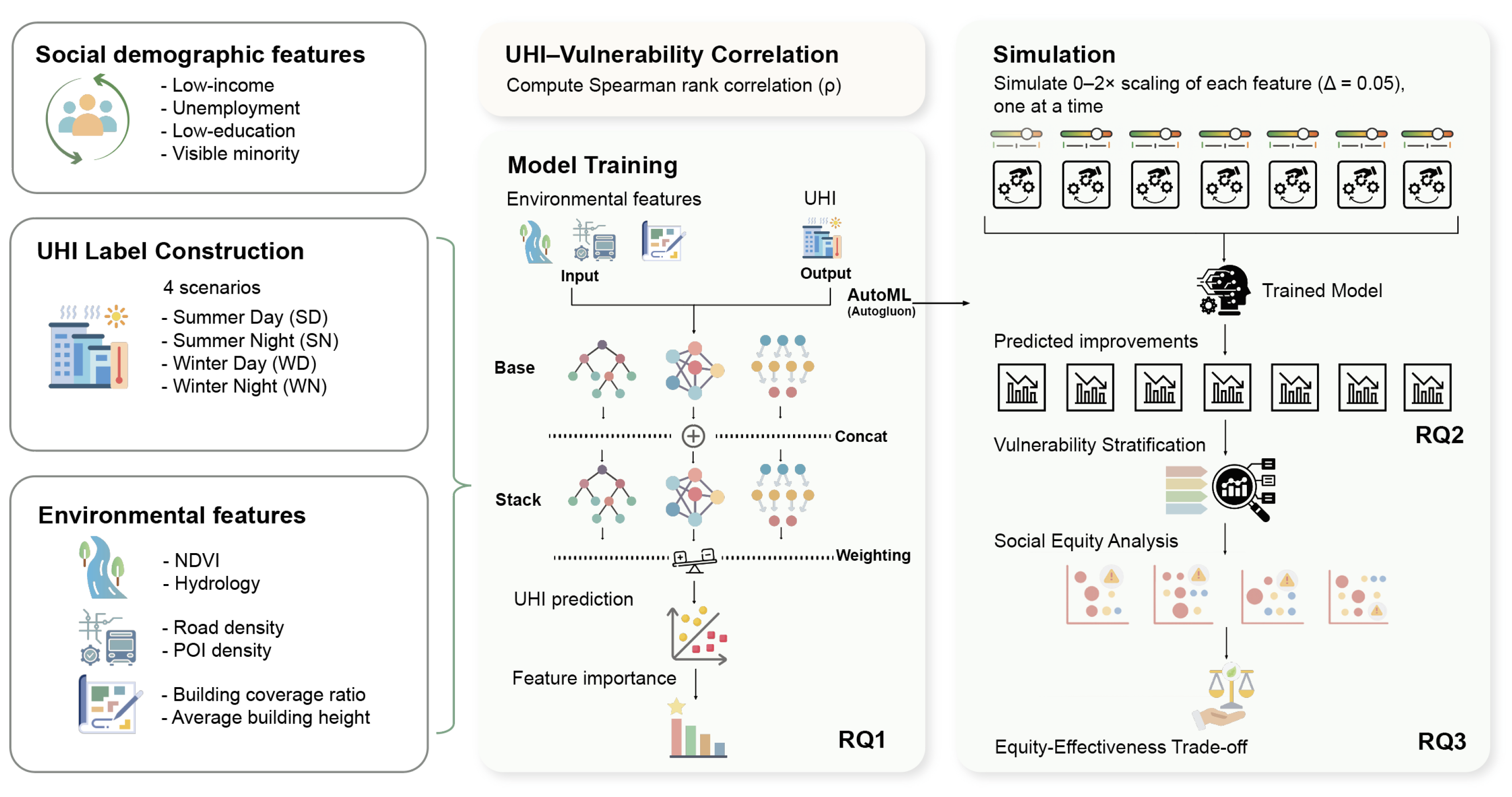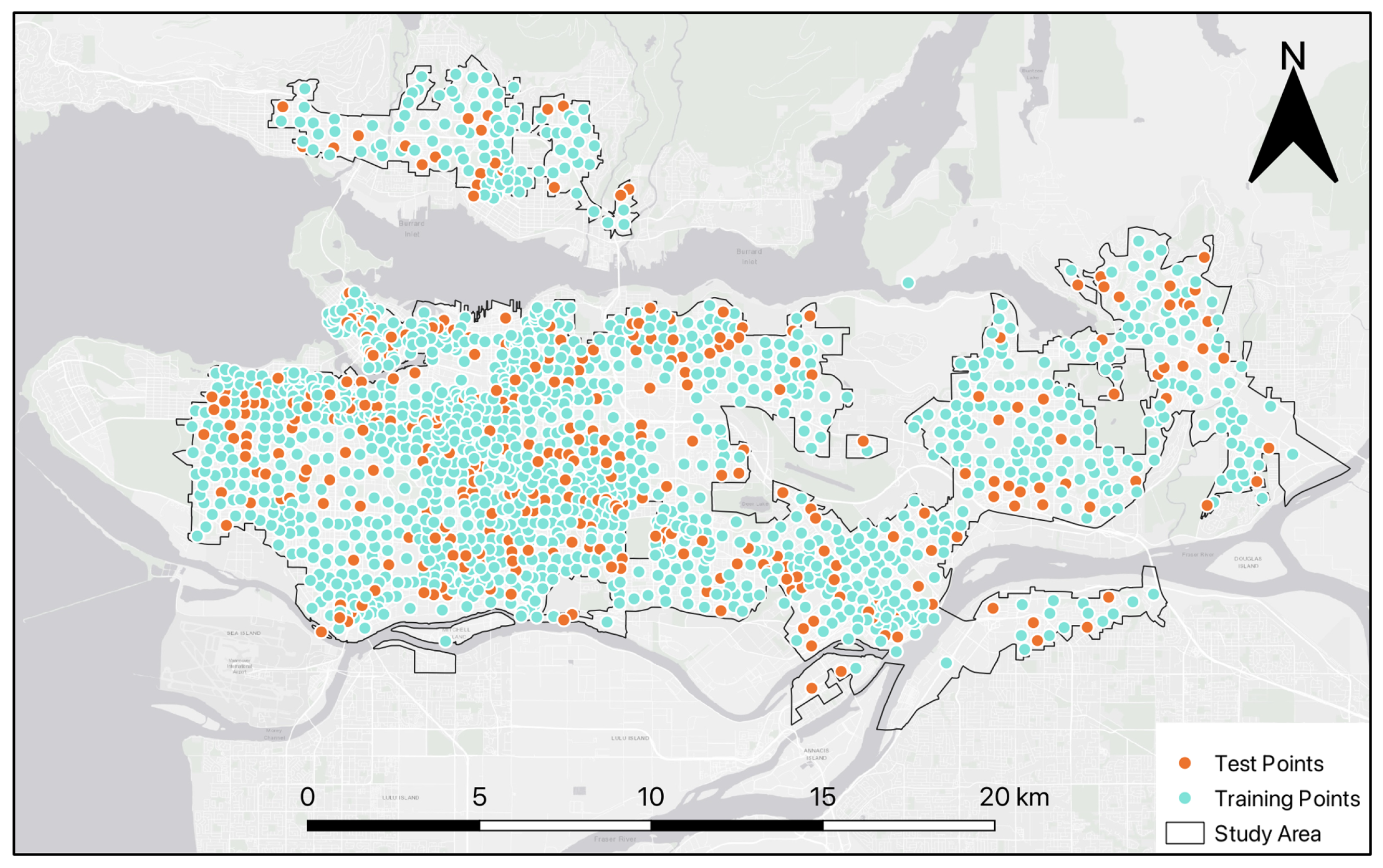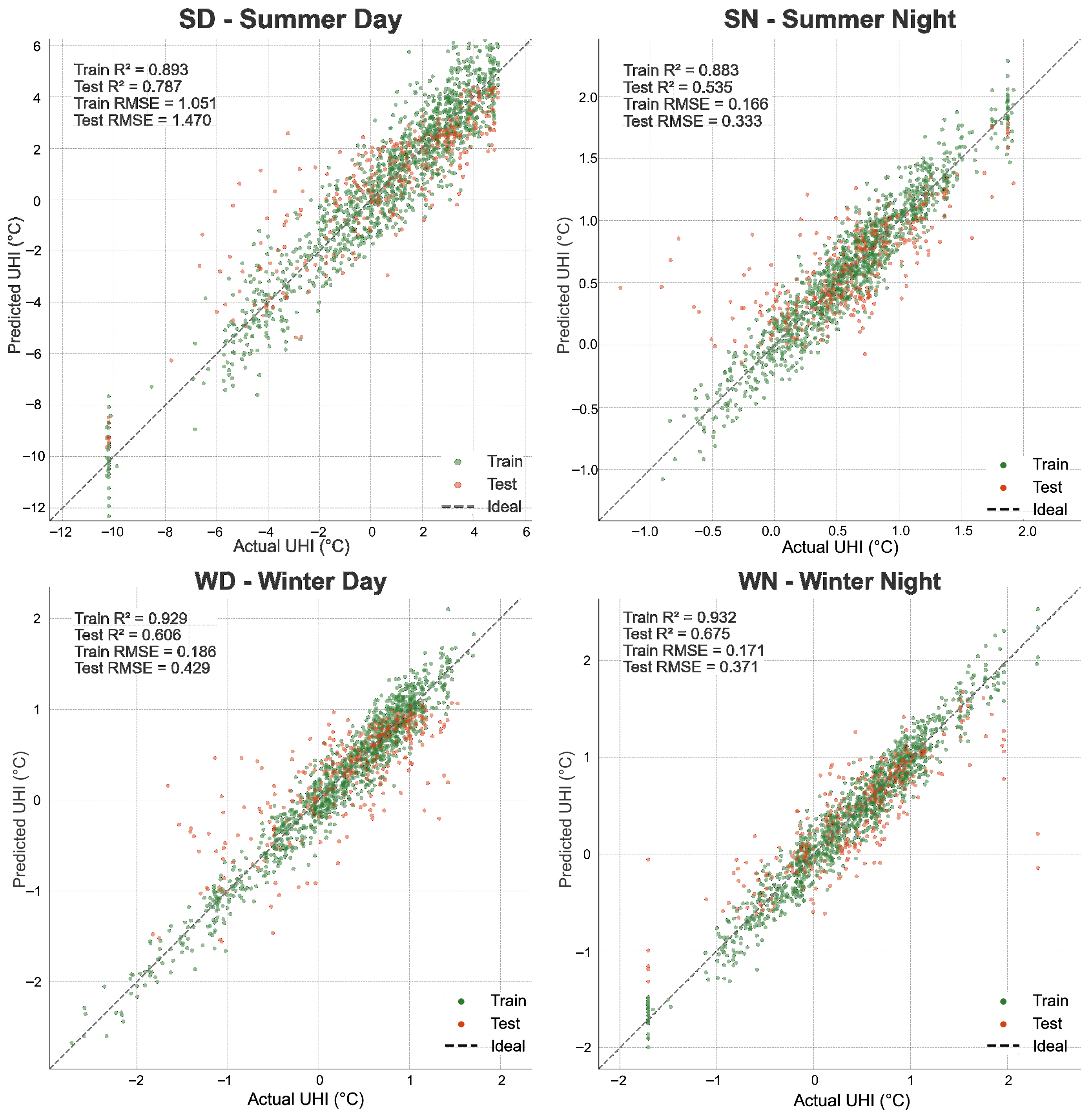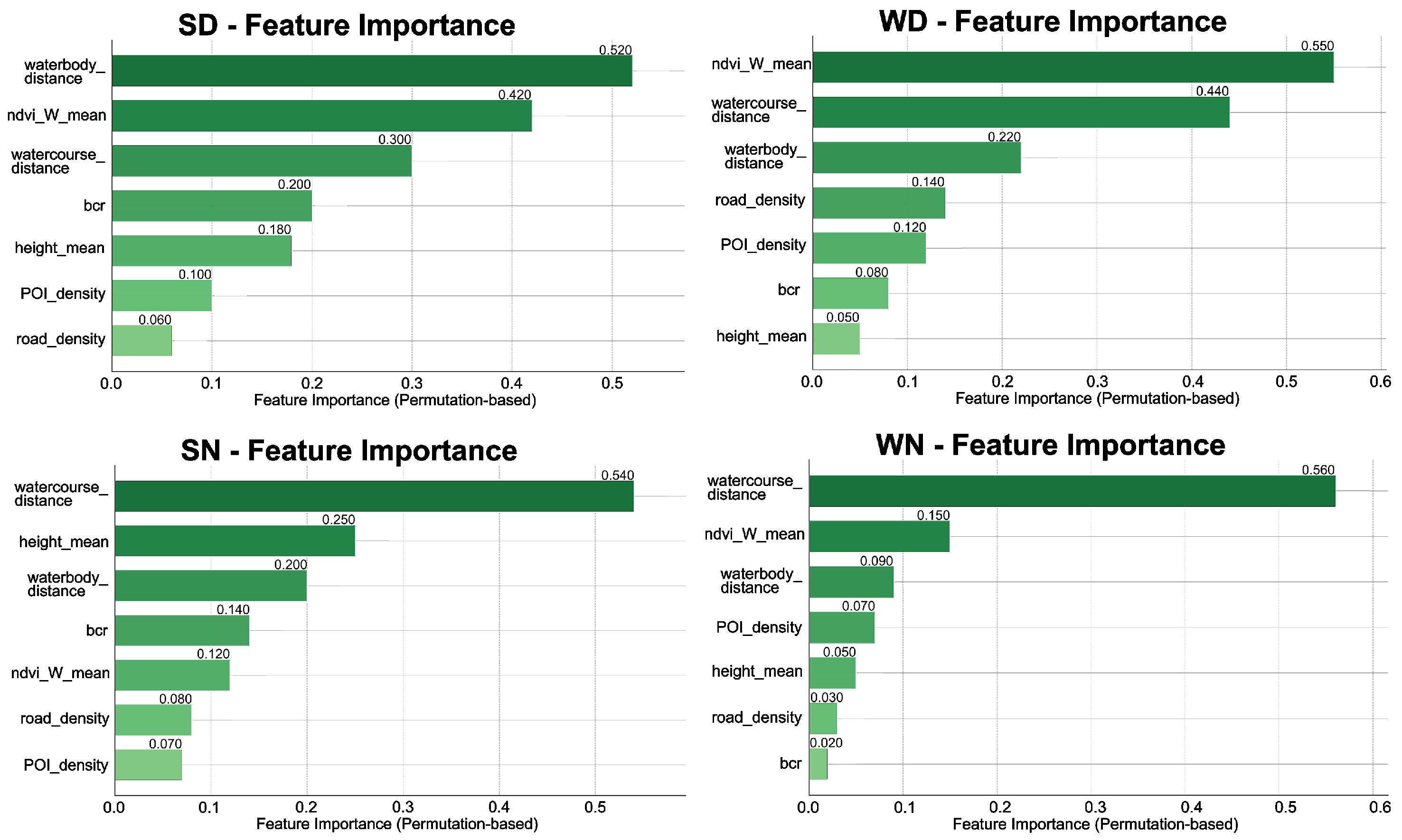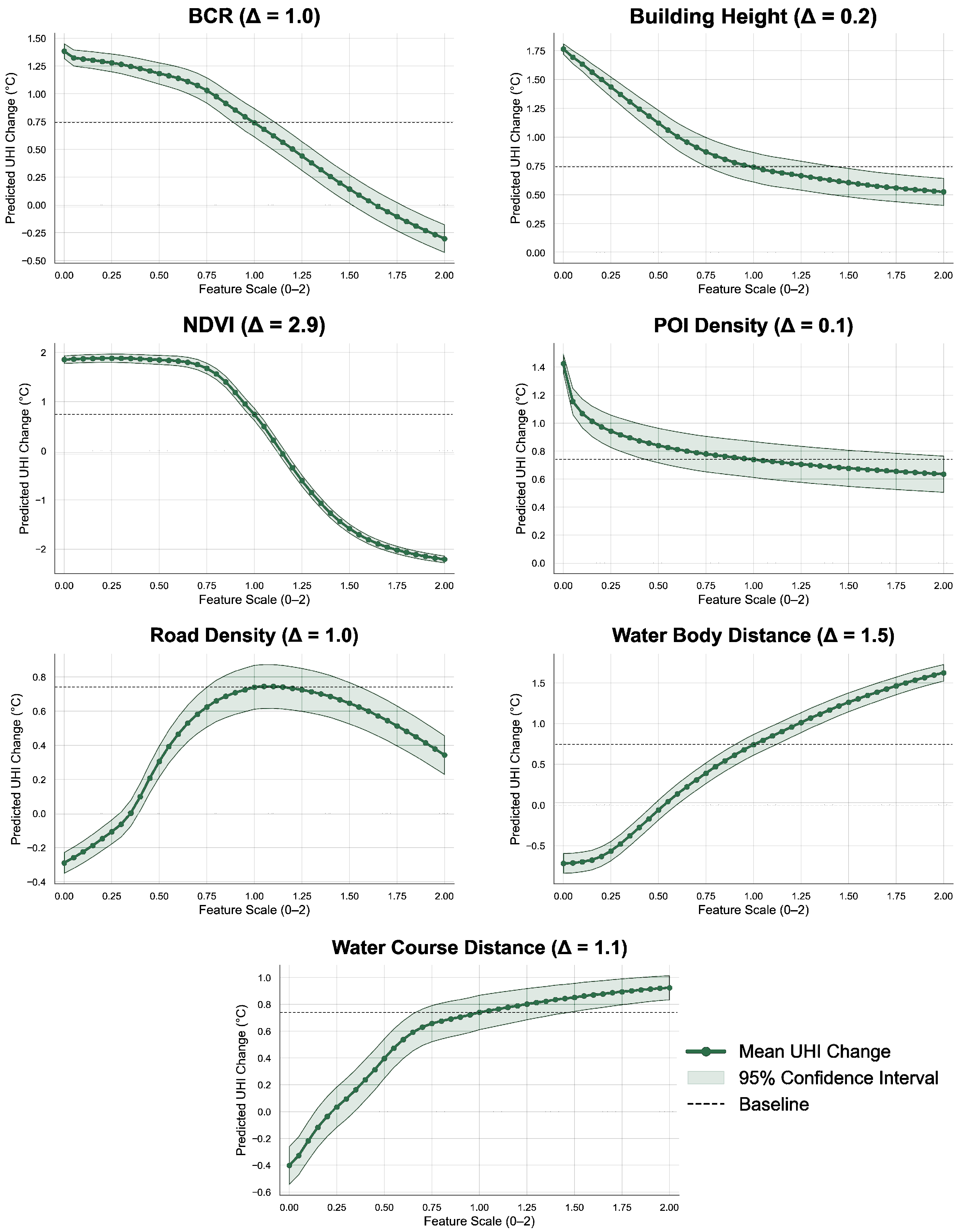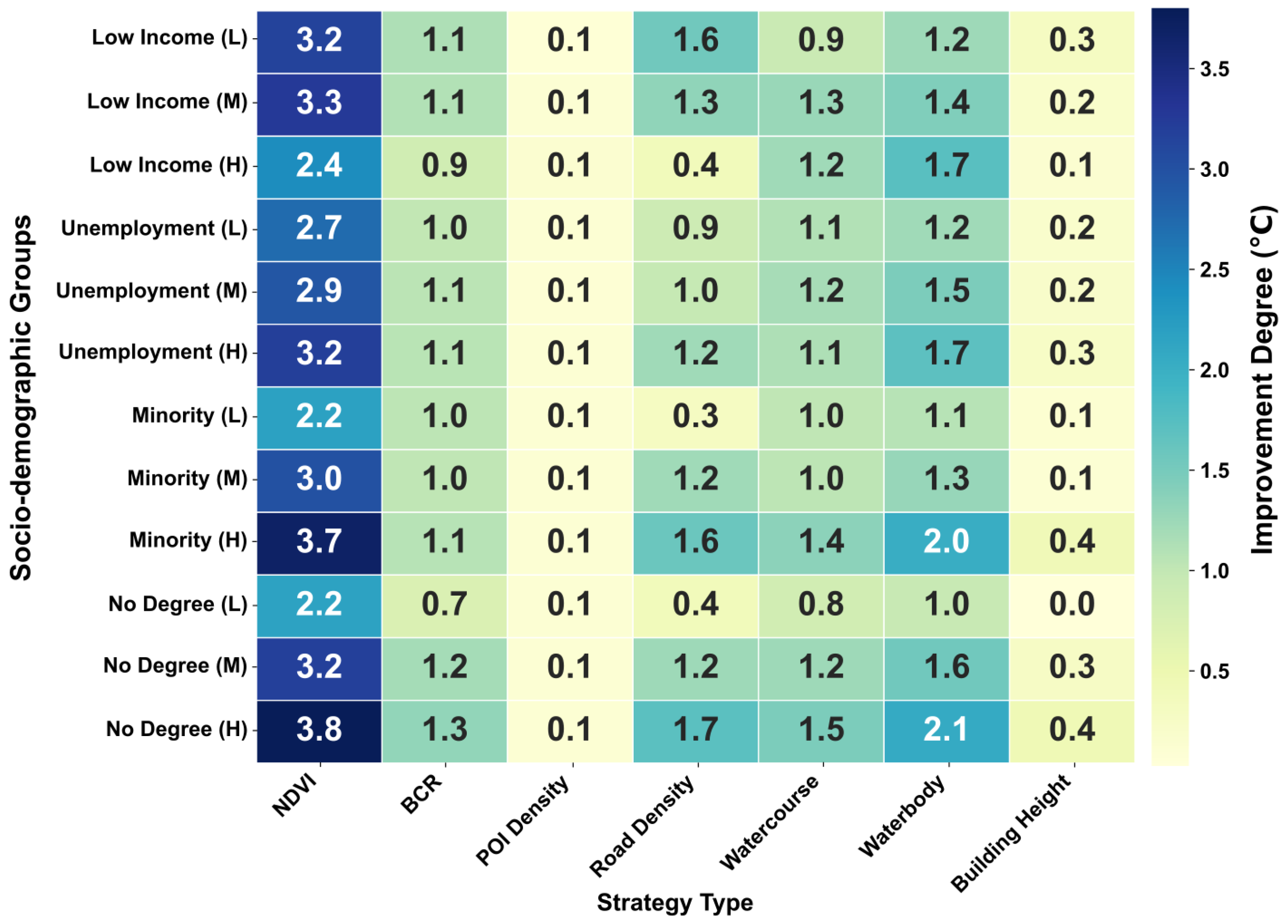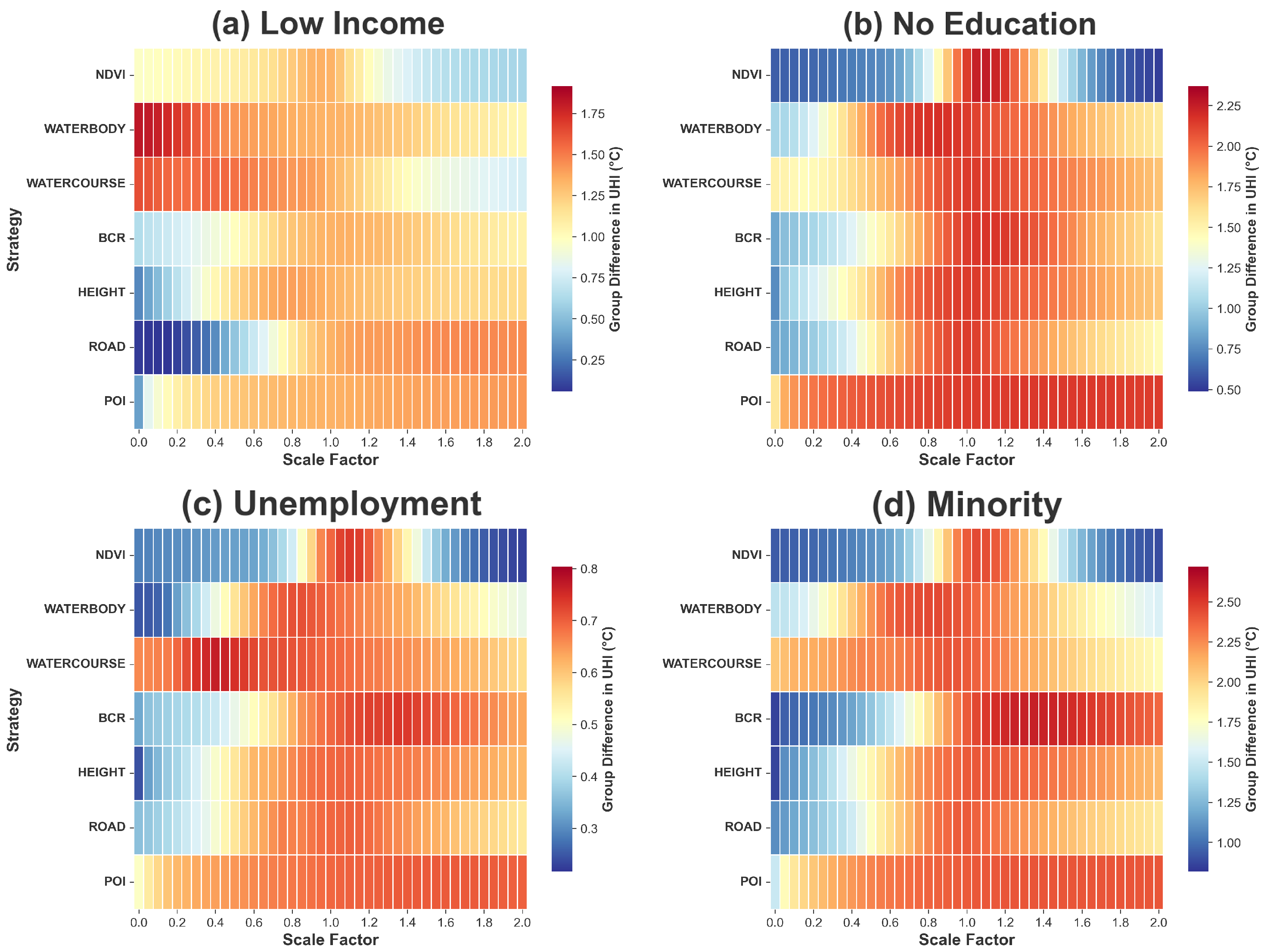1. Introduction
Urban heat exposure has emerged as a critical environmental justice (EJ) concern in the context of accelerating climate change. Vulnerable populations—such as low-income, racialized, and socially disadvantaged groups—often face disproportionate exposure to extreme urban temperatures due to systemic inequalities in land use, housing, and infrastructure planning [
1,
2,
3]. In many urban areas, these groups are more likely to live in neighborhoods with fewer trees, higher building density, and limited access to cooling infrastructure, which exacerbates their vulnerability during heat events [
4,
5,
6,
7]. Such environmental disadvantages are frequently coupled with social and economic stressors, including limited mobility, healthcare access, and adaptive capacity [
2,
8,
9]. These conditions not only increase direct exposure to heat but also reduce the ability to respond effectively. These inequities are particularly pronounced in metropolitan areas where the Urban Heat Island (UHI) effect amplifies baseline climate stress, threatening public health, social well-being, and long-term urban resilience.
Prior research has made important strides in documenting the unequal distribution of UHI exposure across socio-demographic groups [
5,
8,
10]. Studies have consistently shown that heat risk is strongly associated with neighborhood-level social vulnerability, where low-income and minority communities tend to reside in areas with limited vegetation, higher impervious surface coverage, and insufficient cooling infrastructure [
5,
6,
11]. For instance, Voelkel et al. [
12] and Chakraborty et al. [
4] demonstrated that UHI intensity correlates with patterns of residential segregation and historical planning inequities, resulting in higher heat exposure for marginalized populations. Similar findings have been reported in cities across North America and Europe, highlighting that these disparities persist even after accounting for population density and urban morphology [
13,
14]. However, existing studies remain largely descriptive, emphasizing correlations rather than causal mechanisms [
15,
16,
17,
18]. This limitation constrains our understanding of why and under what conditions certain environmental configurations exacerbate or mitigate urban heat. Most prior research has also focused on static associations within single time frames, overlooking the temporal variability of UHI and the shifting vulnerability of populations across diurnal and seasonal cycles [
19,
20,
21,
22]. Such oversimplification risks producing incomplete or even misleading policy guidance, since interventions effective under one climatic condition may fail to deliver comparable or equitable benefits under another.
Two critical gaps therefore remain. First, while several studies have examined the correlates of UHI intensity, few have systematically quantified the relative influence of specific environmental determinants such as vegetation, built form, and water proximity across temporal and seasonal contexts [
13,
14]. Without such insight, planners cannot identify which urban features offer the greatest leverage for mitigating heat exposure, limiting evidence-based prioritization. Second, limited research has explored how environmental characteristics interact with social vulnerability to generate differentiated impacts, or whether built-environment interventions can jointly enhance cooling efficiency and distributive equity [
9,
13]. This knowledge gap constrains the development of fair and adaptive urban strategies.
Beyond these empirical limitations, conventional statistical models often rely on linear and independent assumptions, which fail to capture the complex and context-dependent interactions among urban morphology, vegetation, and microclimate. As a result, key mechanisms such as shading, airflow, and land–water interactions remain underrepresented in existing analyses, obscuring the multidimensional dynamics of urban heat.
Recent advances in interpretable machine learning (ML) offer new opportunities to unpack the complex, non-linear interactions among environmental predictors and social variables [
23,
24,
25]. By integrating high-resolution spatial datasets, ML models can capture non-linear relationships and higher-order interactions between environmental features and socio-demographic variables—patterns that are often difficult to detect using traditional statistical methods [
17,
26,
27]. This is particularly valuable in urban heat studies, where the drivers of thermal exposure are both context-dependent and interrelated across scales [
17,
26]. ML frameworks also enable flexible prediction across multiple temporal and seasonal scenarios, allowing for consistent comparison of environmental influences under varying conditions [
18,
28]. Importantly, these models support counterfactual simulations, making it possible to estimate how specific interventions (e.g., increased vegetation or reduced building density) might alter heat exposure outcomes for different population groups [
18,
27]. Such data-driven simulation capabilities are particularly critical for advancing environmental justice, as they enable an explicit evaluation of trade-offs between cooling benefits and fairness outcomes—an area where current planning practice remains largely assumption-driven rather than evidence-based.
Consequently, viewing the above challenges, this study addresses these gaps by developing a data-driven, fairness-oriented analysis of UHI exposure in Vancouver, Canada. Specifically, we construct a multi-scenario modeling framework to predict UHI intensity across 1660 Dissemination Areas using seven environmental features and evaluate their distributional impacts across four social vulnerability dimensions. We employ AutoGluon—a high-performance Automated Machine Learning (AutoML) framework—to build ensemble-based regression models across four seasonal-temporal scenarios: Summer Daytime, Summer Nighttime, Winter Daytime, and Winter Nighttime [
29]. Building on the model outputs, we simulate environmental interventions by scaling individual features and assess their cooling potential and equity implications for different social groups [
23].
This research is guided by the following questions:
RQ1: What are the most influential environmental features driving UHI intensity under different temporal and seasonal conditions?
RQ2: Which types of environmental interventions provide the greatest cooling benefits in high-risk periods, such as summer daytime, and how do their impacts vary with intervention scale?
RQ3: To what extent can environmental interventions reduce UHI exposure equitably across social groups?
Taken together, this study makes important contributions across theoretical, methodological, and practical domains. Theoretically, it extends the discourse on environmental justice by examining how urban form interacts with social vulnerability to shape differential heat exposure, revealing that thermal inequities are not only socioeconomic but also spatially embedded. Methodologically, it introduces a scalable, interpretable ensemble machine learning framework that integrates high-resolution environmental and demographic data to predict UHI patterns and simulate targeted interventions—advancing a reproducible and flexible toolkit for urban climate modeling. Practically, the study offers actionable insights for equity-sensitive urban planning by identifying which environmental strategies—such as greening and road network adjustments—can deliver both maximum cooling and distributive fairness. This integrated approach lays a foundation for data-driven, socially just, and climate-resilient urban adaptation.
2. Dataset and Methodology
The primary objective of this study is to develop a data-driven framework to quantify the determinants of Urban Heat Island (UHI) exposure and evaluate the equity implications of mitigation strategies. Specifically, we aim to predict UHI intensity under varying seasonal and diurnal conditions, identify the most influential environmental features, and simulate intervention scenarios to assess both cooling effectiveness and social fairness.
To achieve this, the methodology integrates multiple components: (i) the construction of UHI labels for four representative scenarios—Summer Daytime (SD), Summer Nighttime (SN), Winter Daytime (WD), and Winter Nighttime (WN)—using satellite-derived land surface temperature [
30]; (ii) the compilation of environmental predictors (e.g., vegetation index, hydrological proximity, road and POI density, and built-form attributes) and socio-demographic indicators representing population vulnerability [
31]; (iii) the application of an ensemble-based AutoML framework (AutoGluon) for UHI prediction and feature importance analysis; and (iv) scenario-based simulations to estimate the cooling potential of scaled interventions (0–2×) across seven environmental features. These simulations are further stratified by socio-demographic groups to quantify disparities in benefits, providing an evidence base for equitable adaptation strategies.
Figure 1 illustrates the overall research workflow. The process begins with data acquisition and feature engineering, followed by model training and evaluation across four seasonal–diurnal contexts. Feature importance analysis addresses RQ1 by revealing the key environmental drivers of UHI. Subsequently, intervention simulations estimate the marginal cooling effect of environmental modifications (RQ2) and examine the distributional equity of benefits among vulnerable and non-vulnerable populations (RQ3). This integrated approach enables the joint assessment of environmental performance and social justice trade-offs in climate adaptation planning.
2.1. Study Area and Data Sources
This study focuses on 1660 Dissemination Areas (DAs) in the metropolitan region of Vancouver, Canada. The city was selected due to its Mediterranean-influenced climate, characterized by hot dry summers and mild wet winters, which amplify the seasonal dynamics of the Urban Heat Island (UHI) effect. Vancouver also offers comprehensive spatial and socio-demographic datasets, and exhibits diverse urban morphologies and socioeconomic heterogeneity, making it a suitable site for examining the environmental and social determinants of UHI exposure. Various datasets are collected for the study, as shown in
Table 1.
2.1.1. UHI Label Construction
The prediction target is Urban Heat Island (UHI) intensity derived from satellite-based land surface temperature (LST). Although LST reflects surface-level thermal conditions rather than human-perceived air temperature, it remains a widely accepted and spatially consistent proxy for assessing relative heat exposure across urban areas, particularly when examining fine-scale spatial variability [
29]. We computed UHI for four representative situations in 2018—Summer Daytime, Summer Nighttime, Winter Daytime, and Winter Nighttime. Pixel values were aggregated to the Dissemination Area (DA) level by averaging all pixels intersecting a DA and weighting each pixel by its overlap area with the DA polygon. The resulting DA-level UHI values are expressed in degrees Celsius [
4]. All DAs were retained as observations in a continuous regression setting rather than a hotspot classification task.
2.1.2. Environmental Features (7)
We constructed seven neighborhood-scale predictors capturing land surface, built form, and blue–green infrastructure:
BCR: The share of a DA’s area that is covered by building footprints.
Mean Building Height: The average building height within a DA, weighted by building footprint area so that larger buildings contribute proportionally more.
NDVI: The mean greenness within a DA computed from Sentinel-2 imagery and summarized across all intersecting pixels using area weights.
Distance to Nearest Watercourse: Straight-line distance from the DA centroid to the closest mapped stream or river.
Distance to Nearest Waterbody: Straight-line distance from the DA centroid to the nearest lake or pond polygon.
POI Density: Number of POI per square kilometer within the DA boundary, used as a proxy for human activity intensity.
Road Density: Total length of roads within a DA normalized by its area (kilometers of road per square kilometer of land).
All spatial layers were harmonized to a common coordinate reference system (EPSG:3347). Raster-vector overlays, zonal statistics, and nearest-neighbor distance operations were used to derive DA-level summaries. These environmental features have been widely recognized in the literature as important determinants of UHI variability and heat exposure inequities [
4,
12,
31].
All input features were normalized using Min-Max scaling:
No additional dimensionality reduction was applied in order to preserve the complete environmental and socio-demographic information contained in the dataset. Furthermore, to ensure model interpretability and reduce multicollinearity, feature selection was guided through permutation importance and correlation screening.
2.1.3. Socio-Demographic Features (4)
To characterize population vulnerability, we included four census-based indicators at the DA level, which are widely employed in environmental justice and UHI vulnerability assessments to represent dimensions of social disadvantage [
21,
32]:
Unemployment Rate: Share of the labor force (15+ years) that is unemployed.
Low-Income Share: Proportion of residents below the official low-income threshold.
No High-School Diploma: Proportion of residents aged 25+ without a secondary school diploma.
Visible Minority Share: Proportion of residents who self-identify as members of a visible minority group (Statistics Canada definition).
2.2. Modeling UHI via Ensemble AutoML Framework
We formalize the Urban Heat Island (UHI) prediction task as a supervised regression problem. For each Dissemination Area
i, the surface UHI intensity is modeled as a function of environmental predictors:
where the following:
is the predicted UHI intensity for area i;
represents a p-dimensional feature vector (e.g., NDVI, building coverage, road density);
denotes the ensemble prediction function learned by AutoGluon;
is the residual error term;
The ensemble model
F is trained using AutoGluon, a high-performance AutoML framework that integrates multiple base learners
, and combines them using bagging and multi-layer stacking strategies. Specifically, the ensemble prediction is defined as
where
is the optimized weight assigned to base model
, obtained via internal validation.
2.2.1. Model Architecture
The base learners include the following:
CatBoost: gradient boosting on categorical features;
NN-Torch: fully connected neural networks;
XT (Extremely Randomized Trees): an ensemble of decorrelated decision trees.
The AutoML pipeline uses the following:
Bagging folds: –6, to reduce variance via bootstrap aggregation;
Stacking levels: –2, where predictions from one level serve as inputs to the next;
Hyperparameter optimization: automatically conducted under the ‘best’ preset configuration.
2.2.2. Training Configurations
Separate models were trained for each of the four seasonal scenarios:
Table 2 summarizes the training configurations for each scenario.
All input features were normalized using Min-Max scaling as shown in Equation (
1).
To ensure model interpretability and reduce multicollinearity, feature selection was guided through permutation importance and correlation screening.
2.3. Model Evaluation
We selected an ensemble AutoML framework (AutoGluon), which incorporates CatBoost, neural networks, and extremely randomized trees among others as base learners, providing a balance between interpretability, non-linear fitting capacity, and computational efficiency [
17,
28]. This framework enables robust and transparent modeling across heterogeneous predictors while reducing manual bias in hyperparameter tuning. Model performance was evaluated using the coefficient of determination (
), which also served as the optimization objective during training in AutoGluon (
eval_metric = ‘r2’) [
29].
indicates the proportion of variance in UHI values that is explained by the model; values closer to 1 reflect better fit. To assess generalization, we report separate
scores for the training and testing subsets for each seasonal–diurnal scenario. Feature importance was quantified with AutoGluon’s permutation-based procedure (
predictor.feature_importance()). The method randomly shuffles one feature at a time and measures the resulting deterioration in model performance [
29,
33]. This implementation evaluates feature importance consistently across all base learners (CatBoost, NN-Torch, and XT) using the same permutation framework, rather than relying on algorithm-specific definitions such as split counts or gain-based metrics in CatBoost. The permutation approach was chosen for its model-agnostic nature and interpretability, as it directly quantifies the marginal contribution of each predictor to overall model accuracy. It returns an importance score together with the associated standard deviation,
p-value, and confidence interval, enabling both ranking of predictors and assessment of their statistical robustness.
All evaluations used an 80/20 train-test split with a fixed random seed (42) to ensure reproducibility across runs. To confirm model stability, the training–testing procedure was repeated several times with randomly partitioned subsets, and the resulting values remained highly consistent across runs, showing only minimal variation (<0.02). Model regularization was achieved through AutoGluon’s ensemble mechanisms, including bagging (), multi-layer stacking (), and early stopping based on validation loss. Overfitting was further mitigated by L2 regularization in CatBoost () and by dropout () and weight decay () in neural networks.
Hyperparameter optimization was performed using pre-optimized configurations under the preset ‘best’. Key parameters included learning rates (0.02 for CatBoost, 0.0027 for neural networks), tree depth (10), and regularization coefficients determined from prior tuning experiments to maximize validation performance. These transparent and reproducible steps ensure that the ensemble modeling process is scientifically rigorous rather than a black-box procedure. For transparency, we additionally visualize performance with scatter plots of observed vs. predicted UHI and summarize feature rankings across scenarios.
2.4. Effectiveness Evaluation of Various Practice-Based Urban Development Strategy via Scenario Simulation
To evaluate the effectiveness of different environmental interventions on mitigating Urban Heat Island (UHI) intensity, we designed a scenario-based simulation framework. The objective was to quantify the cooling effect of modifying individual environmental features while keeping all other factors constant. This approach isolates the marginal contribution of each feature, enabling planners to prioritize interventions with the greatest potential impact [
25,
30].
2.5. Intervention Scenario Simulation
Each environmental feature (e.g., NDVI, BCR, road density) was scaled individually over a predefined intervention range:
where
L represents the total intervention levels. For each level, the scaled feature vector is expressed as
where
n is the total number of features, and
is the scaling factor applied to feature
j, while all other features remain at their baseline values.
The predictive UHI for each intervention level is then computed using the trained AutoML regression model:
where
denotes the ensemble learning model [
19].
2.6. Effectiveness Metric
To quantify the maximum cooling benefit of each intervention, we define the improvement metric as
where the following:
This metric captures the greatest achievable reduction in UHI intensity through scaling of a single environmental feature within the intervention range.
2.7. Social Equity Assessment
To evaluate the equity implications of environmental interventions, we simulated their effects across socio-demographic subgroups. Four vulnerability indicators were considered: low income, unemployment, low educational attainment, and visible minority status [
4,
6,
9,
32]. For each indicator, Dissemination Areas (DAs) were stratified into three vulnerability tiers—low, medium, and high—based on their empirical quantile distribution. This stratification resulted in a total of 12 subgroups for equity analysis.
2.7.1. Equity Evaluation Framework
After applying an intervention scenario, the predicted UHI values for each subgroup were computed as
where the following:
G represents the set of DAs in subgroup g;
denotes the feature vector for DA i under intervention level l;
is the trained AutoML prediction model.
2.7.2. Fairness Metric
To capture the extent of disparity in cooling benefits across subgroups, we define the Max Group Difference (MGD) as
where
is the number of subgroups for a given vulnerability indicator.
A lower MGD indicates greater equity, meaning UHI exposure after intervention is more evenly distributed across vulnerability groups. This metric allows us to compare interventions not only by their overall cooling effect but also by their ability to reduce socio-spatial disparities.
4. Discussion
4.1. Effectiveness and Fairness of Environmental Interventions
This study demonstrates that nature-based strategies—particularly increasing urban vegetation—deliver the most substantial and equitable reductions in urban heat exposure. Vegetation-based interventions (NDVI) achieved the highest potential cooling of 2.95 °C, approximately 3.9 times greater than that of built-environment modifications (average 0.76 °C). For low-education populations, NDVI interventions yielded the smallest group disparity (0.52 °C at scale = 2.0), making it the most effective and equitable overall strategy for residents without formal education. However, an “equity trap” was identified between scale = 1.1 and 1.3, where group disparity peaked at approximately 2.2 °C. Therefore, fairness improvements became more stable once vegetation intensity exceeded about 1.3 times the baseline level. These results reaffirm the dual role of greening in mitigating thermal stress while advancing climate justice.
Built environment interventions—such as reducing road density or modifying BCR—also showed fairness-enhancing potential, though their cooling impacts were more modest. For example, BCR at scale = 0.0 yielded the most equitable outcome for visible minority groups (group difference = 0.86 °C), and road density adjustments improved fairness among low-income populations. Specifically, Road Density at scale < 1.0 showed consistent inequality reduction across all social groups. Notably, for low-income populations, the minimum group difference (0.062 °C) was achieved at scale = 0.15. As the scale decreases, inequality also decreases, making Road Density a strong candidate for targeted, equitable interventions. These findings suggest that scale-sensitive, targeted modifications to urban form can achieve meaningful equity gains, even when total cooling is limited.
Our group-based analysis further revealed that high-vulnerability populations—such as low-education or high-minority groups—often benefited more from environmental interventions than their low-vulnerability counterparts, with an additional cooling gain of approximately 1.5 °C. This responsiveness challenges static narratives of persistent disadvantage and highlights the importance of designing interventions that account for group-specific sensitivity to urban heat mitigation.
These findings are broadly consistent with previous research showing that urban greening substantially mitigates surface heat intensity, with cooling effects strengthening as vegetation density increases [
15]. Moreover, differential cooling among vegetation types observed in tropical and temperate regions [
16] supports our conclusion that vegetation structure influences both thermal performance and equity outcomes. The additional benefits of water-related features identified in this study further align with global assessments of blue–green infrastructure as a synergistic cooling mechanism [
19].
4.2. Complexities of Context-Dependent Urban Heat Dynamics
Several findings challenged common assumptions about urban heat exposure and social vulnerability. For instance, low-income populations were negatively correlated with UHI during Summer Daytime (), likely due to peripheral housing areas with better ventilation or vegetation, but showed positive correlations at night and in winter. These temporal reversals suggest that vulnerability to heat is not static but shifts with season and time of day.
Another counterintuitive result was the high cooling efficacy of built-environment intensification—such as increased building height or coverage—at scale = 2.0. While dense morphology is often blamed for worsening UHI, our simulations indicate possible shadowing or airflow effects that reduce heat exposure under certain configurations. Specifically, the Building Coverage Ratio (BCR) at scale = 2.0 achieved a cooling benefit of approximately 1 °C, suggesting that high-density forms can sometimes facilitate shading and convective heat dispersion. Additionally, the cooling impact of NDVI dropped sharply at night, underscoring the time-sensitive nature of vegetation effects.
These temporal and morphological patterns are consistent with global evidence showing that daytime SUHI intensity typically exceeds nighttime levels due to differential radiative and aerodynamic controls [
34]. Similar diurnal and seasonal reversals have also been reported across South Asian cities [
20,
21], suggesting that social and environmental vulnerability to heat varies dynamically through time. Furthermore, regional studies in arid and continental settings [
22] reinforce the context-dependent and non-linear nature of UHI processes. At the same time, our observation that compact urban forms can under certain configurations yield local cooling effects aligns with recent global analyses emphasizing morphology optimization rather than simple densification or sprawl reduction as the pathway to sustainable heat mitigation [
35].
These findings point to the non-linear, context-dependent nature of UHI dynamics. Factors such as ventilation corridors, elevation, and microclimatic variation may mediate thermal exposure in ways not fully captured by conventional planning assumptions. Moreover, the stronger cooling gains observed among some socially vulnerable groups highlight the need to move beyond uniform intervention strategies and adopt more nuanced, data-driven planning approaches.
4.3. Methodological Contributions, Limitations, and Future Directions
Methodologically, this study contributes a scalable framework for evaluating both the effectiveness and equity of urban heat mitigation strategies. By integrating AutoGluon’s ensemble learning models with fine-grained spatial and socio-demographic data, we were able to model UHI exposure under four seasonal and diurnal conditions, simulate 41 levels of intervention per environmental feature, and assess group-level disparities. Importantly, the proposed workflow is transferable to other urban contexts, provided that comparable environmental and demographic datasets are available. The model’s modular structure allows users to adapt the input features, retrain the ensemble on local data, and simulate city-specific intervention scenarios, thereby facilitating cross-city or cross-climate applications. This pipeline provides a reproducible blueprint for equity-oriented climate adaptation planning.
Despite its strengths, the study has several limitations. Although regularization techniques were applied during model training, some degree of overfitting was still observed in complex thermal contexts—particularly during Summer Nighttime (SN), Winter Daytime (WD), and Winter Nighttime (WN). This may result from data sparsity, meteorological fluctuations, and weaker nighttime radiative signals, which collectively reduce the model’s generalization capacity. The interpretability of AutoML remains limited, making it harder to trace specific non-linear interactions between features. Furthermore, this study’s geographic scope—restricted to Vancouver in 2018—limits generalizability across other cities or climates. Endogenous relationships (e.g., between vegetation and income) also complicate causal inference. Additionally, the correlation-based assessment of social vulnerability was exploratory in nature and does not capture complex mediating or spatially confounding relationships among socio-demographic factors.
Looking ahead, future research could mitigate such overfitting risks through sample expansion, refined feature selection, or spatiotemporal modeling approaches that better capture contextual variability. In addition, longitudinal designs that incorporate decadal climate trends and extreme heat events would enhance the temporal robustness of the findings. Causal inference techniques (e.g., structural equation modeling or natural experiments) could strengthen understanding of underlying mechanisms. At finer spatial scales, high-resolution data from IoT sensors or crowdsourced platforms could uncover hidden inequities. Beyond these methodological directions, future efforts should focus on bridging model results with real-world implementation by integrating crowdsourced and Volunteered Geographic Information (VGI) data to enable participatory validation and local feedback. Such an approach can connect data-driven insights with lived experiences, supporting policymakers in evaluating trade-offs between cooling effectiveness, social equity, and feasibility under actual governance and spatial constraints. From a policy perspective, incorporating cost-benefit analysis, stakeholder feedback, and multi-objective optimization will be crucial for operationalizing simulation findings. In particular, applying and validating this framework across different climatic zones (e.g., arid, tropical, continental) and governance contexts could help identify universal versus context-specific drivers of urban heat inequity. Cross-city comparisons and links to health and economic outcomes would further enhance the impact and relevance of equity-centered UHI mitigation strategies.
5. Conclusions
Urban heat inequality has emerged as a pressing environmental justice issue, with vulnerable populations—such as low-income, low-education, and racialized groups—often facing disproportionate exposure to extreme urban temperatures [
4].
This study presents a novel machine learning-based approach to investigate how urban environmental features influence the distribution of Urban Heat Island (UHI) exposure across space, time, and social groups. By applying an interpretable AutoML framework to high-resolution spatial data from Vancouver, we identify vegetation cover (NDVI), proximity to water, and built form indicators as key drivers of UHI patterns. Scenario-based simulations reveal that greening strategies not only provide the strongest overall cooling effects, but also consistently deliver equitable benefits to socially disadvantaged communities. Other interventions, such as modifying building density or road layout, also show potential for targeted fairness improvement. These findings highlight the spatial and temporal complexity of heat vulnerability, underscoring the need for localized, equity-sensitive adaptation strategies in urban climate planning.
From a theoretical standpoint, this study contributes to the evolving discourse on climate justice by integrating urban morphology, social vulnerability, and data-driven modeling. It moves beyond conventional correlational approaches by leveraging interpretable machine learning to reveal non-linear, context-dependent relationships between urban form and environmental inequity. Our results demonstrate that thermal disparities are not merely socioeconomic artifacts, but are materially embedded in the spatial configurations of the built environment. The methodologically grounded framework developed here offers a new lens to investigate the intersection of spatial form and social inequality, enriching existing environmental justice theories with a spatial analytic perspective.
On a practical level, our research delivers actionable insights for urban planning and policy-making. The strategy evaluation framework enables practitioners to test the thermal and distributional effects of various interventions before implementation, thereby supporting data-informed, equity-oriented decision-making. Moreover, the modeling framework is transferable and adaptable to other cities, provided local environmental and demographic data are available [
3]. As cities worldwide confront rising heat risks, the findings of this study can support the formulation of socially just and spatially effective adaptation strategies aligned with broader sustainability agendas, particularly SDG 11 and SDG 13 [
36].
Despite these contributions, the study is not without limitations. First, the analysis is limited to one city and one year (Vancouver, 2018), which restricts generalizability across climatic and governance contexts. Second, while model performance was strong in summer daytime scenarios, other periods (e.g., summer night, winter day) exhibited signs of overfitting, indicating sensitivity to spatiotemporal complexity. Third, the study remains correlational in nature, and causal mechanisms behind observed inequities require further investigation. Finally, policy, historical, and behavioral variables—potentially crucial in shaping environmental injustice—were not directly modeled. Future research should build upon this framework by incorporating longitudinal and causal methods, expanding the scope to diverse urban contexts, and integrating health, economic, and behavioral data to enhance both scientific understanding and policy relevance in the pursuit of urban climate justice.
